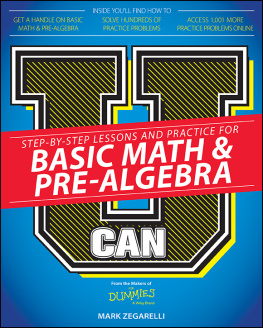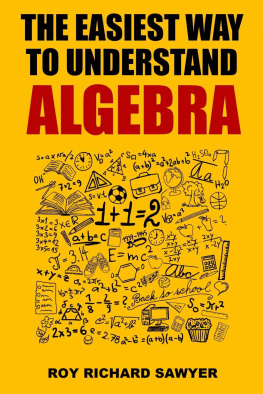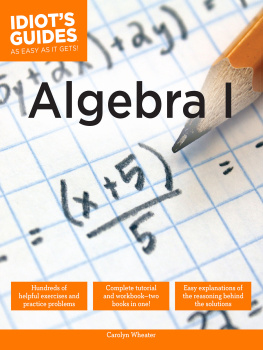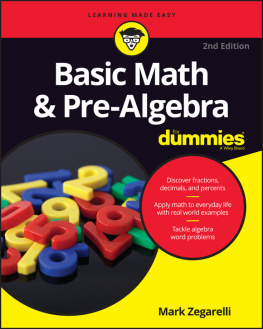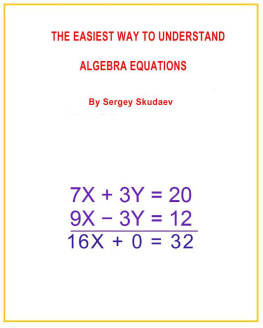100 Fully Solved Equations To Explain Everything You Need To Know To Master Algebra!
First, Get My FREE GIFT!

For a limited time, you can download this book for FREE!
CLICK HERE TO GET IT NOW!
Copyright 2019 Math Wizo
All rights reserved. No part of this book may be reproduced or transmitted in any form or by any means, electronic or mechanical, including photocopying, recording, or by any information storage and retrieval system without permission of the publisher, except for the inclusion of brief quotations in a review.
ISBN: 9781792889660
Table of Contents
Algebra:
Explained The Easy Way with 100 Fully Solved Equations
You are about to embark on a journey into mathematics, so dont freak out. More specifically, this journey is all about algebra, which is basically one of the major divisions of math. While your experience with algebra may have so far been confusing, this book is designed to make it simpler for you. Algebra is, in fact, a way to look at math problems that actually makes math problems simpler. This is especially true of word problems, which can be converted easily into basic algebra problems that you will be able to solve after reading this.
The key thing to know about algebra is that is based not only on numbers but on things called variables. What is a variable? A variable is something about the problem that you dont know the value of. In fact, algebra can be considered a type of mathematics that is concerned with the solving or determination of what number value the variable has. In algebra, mathematicians use placeholders, such as x, y, and z to indicate that these represent numbers of which we do not yet know the value. Your job is to know what the value of the variable is based on the rest of the known numbers in the equation.
The rest of algebra is basically the same arithmetic youve known since grade school. Addition is still addition, subtraction is still subtraction, and so on. Algebra also uses things like the square of something and the square root of something, which may not be something you truly understood in middle school or high school. The square of something is nothing more than the number multiplied by itself. This would be written like this: Two squared or 2 is the same as saying 2 x 2 or 4. It is written as 2 = 4. In the same way, the cube of something is the number multiplied by itself three times. 2 = 2 x 2 x 2 = 8. The square root is the reverse of this. The square root or of something is the reverse answer to the square of something. For example, the square root of 4 or 4 is 2 because 2 x 2 = 4.
The other thing youll have to remember and do as part of algebra involves the idea that equations are always balanced. In other words, the equation 2 + 2 = 4 means that everything on the left side of the equation or = sign is the same as everything on the right side of the equation. And, if youll think back to grade school, you can manipulate these equations. You can take 2 + 2 = 4 and turn it into 2 = 4 2. Easy, right? Well, in algebra, youll see things like x + 2 = 4, and youll have to solve for x, meaning that you have to put x on one side of the equation and figure out what x means. It looks like this: x = 4 2. The answer is, of course, 2. This is algebra. While there are harder problems than this, you can use these basic rules to solve equations that, in this book, will get harder as we progress.
To be clear about the nomenclature, we will use x, y, z, a, b, and c to represent the variables and it will be up to you to determine the number the variable represents. There will also be some differences in how things are represented in print. In order to avoid confusion, well use these symbols to represent mathematical equations:
- Addition. This will always involve the + sign you are used to seeing.
- Subtraction. This will always involve the " sign you are used to seeing.
- Multiplication. This will be written in one of four ways. The * sign will be used in some equations, such as 2 * 6 = 12. More often, however, you will see it this way: 2(6) = 12 with the parentheses used to represent multiplication with the number next to it. It may also be written like this: (2)(6) = 12. This also represents 2 multiplied by 6. This allows for equations like this: 2(2+4) = 12. In this situation, the mathematical protocol is to do whats in the parenthesis first and then do the mathematical problem of multiplication next. Why do this? Because 2 * 2 + 4 is completely ambiguous. 2 * 2 = 4. Add 4 to that and you get 8. BUT, 2 * (2+4) is the same as 2 * 6 and this answer is 12, not 8. The parenthesis tells you which set of operators to do first. Finally, you might see 2x or 3y. The combination of the integer and the variable together like this means you are supposed to multiply them.
- Division. This is not represented by the sign (although it COULD be used). Instead the / symbol is used so that 2/4 = two-fourths or one-half. In the same way 4/(2+2) is 4/4 or 1. In algebra, you might see 2/x or (3 -2)/y. This is no different than you see when youre just using integers.
- Squared or cubed. This will be as you know it. Squared is x and cubed is x and so on. Know that it is possible to have any number other than 2 or 3, such as x n in which n represents any possible number.
- Square root. The symbol will be used to represent the square root of something. It will be possible to have the equation (2+2), in which the entirety of 2 + 2 is under the square root. Again, the mathematical operators inside the equation are done first and then the square root.
So, in this book, we will look at easy, medium, and hard questions involving algebraic equations. Not only will we solve them together but we will work together to see how these equations get solved. So, if youre ready, well get started.
Chapter 1:
The Basics of Single Variable Problems
In this chapter, youll get your feet wet and will learn how mathematical operators work in solving simple algebraic equations. We wont do many word problems; there will be just a few so you can see how algebra can help.
- Problem 1. Solve 25(x + 2) = 250
In this case, as in all cases of algebra, you will be asked to solve for x. You first need to get as many things on the side of the equation opposite the variable, which in this case is x. Start by putting 25 on the opposite side of the equation. This looks like this: (x + 2) = 250/25. In order to move the 25, you need to put it on the opposite side and divide it into 250.
Another way to do this is to divide both sides by 25. So, 25(x + 2)/25 = 250/25. Thats safe to do because you can divide, multiply, add or subtract anything so long as the same thing is done to both sides of the equation. Either way, you get x + 2 = 10 because 250/25 = 10. This gets a lot simpler. The next thing to do is to move the 2 to the other side of the equation to get x = 10 2. For this reason, the answer is x = 8. Thats all it takes. Whew!
- Problem 2. Solve (x 4)/5 + 15 = 19.
Again, get everything, step-by-step onto the opposite side of the equation as the variable and youve solved for the variable. Start with the 15. If its added on the left side, subtract it from both sides to move it. Then you get (x 4)/5 = 19 15. This translates into (x 4)/5 = 4. Now, we have to get rid of the 5 on the left-hand side. The operators within the parenthesis stay together until the very end. This leaves you with (x 4) = 4 * 5. Again, if its divided on the left side, you have to multiply it on both sides to balance the equation. This leaves you with x 4 = 20. Now, add the 4 to both sides of the equation because its subtracted on the left side to get x = 4 + 20. The answer? x = 24


